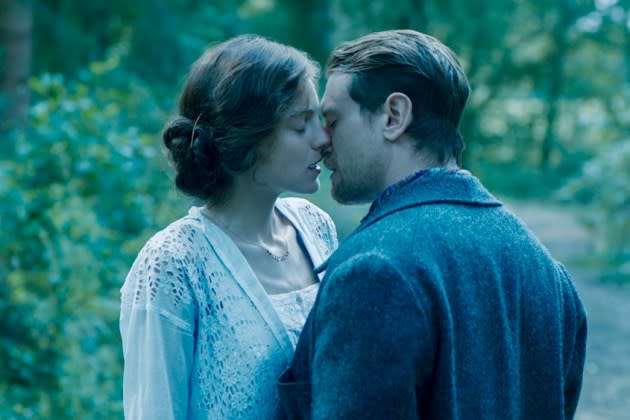Why ‘Lady Chatterley’s Lover’ Resonates With Its Modern Audience
- Oops!Something went wrong.Please try again later.
- Oops!Something went wrong.Please try again later.

If modern filmgoers recognize the title “Lady Chatterley’s Lover,” it’s probably because for decades the name was synonymous with 20th-century book banning — a quaint period piece. But the new Netflix film, directed by Laure de Clermont-Tonnere and written by David Magee, shows that D.H. Lawrence’s work has much more to offer than naughty titillation.
“It’s a love story,” de Clermont-Tonnere says, “and it’s also about a woman who frees herself from class, her marriage and the patriarchy, to take control of her life and take ownership of her body. That resonates today even louder with modern audiences.”
More from Variety
Alexandre Desplat, Olivier Assayas, Patrick Wachsberger Named in France's Oscar Selection Committee
FX's 'A Murder at the End of the World' Delays Hulu Premiere to November
The novel was published privately in 1928 and then publicly in 1960, leading to watershed trials about censorship.
“The body of a woman is still the subject of political tensions,” the director adds. “D.H. Lawrence wanted to express that sexuality is beautiful and pure, nothing shameful.”
Lawrence’s vision was also timely as he addressed the perils of industrialization and the abuse of nature.
But it was banned because he wrote about sexuality — and, even more scandalous, the sexuality of a woman. Plus she falls in love with a man of a lower class.
Near the beginning of the Netflix film, which is a possible Oscar contender, Connie marries Lord Clifford, who soon is injured in WWI and unable to father a child.
Since Clifford has inherited the family business and estate, he feels pressured to produce an heir. So he tells his wife to have an affair and get pregnant. She does have the affair, with Mellors, the estate’s gamekeeper.
“The scene is very faithful to the book,” the director says. “Connie doesn’t know if it’s a modern idea or a terrible idea. He’s asking her to be mechanical. It becomes part of the idea of the machine, the industry in England destroying nature.”
Clifford is also becoming mechanical; he aspires to be a novelist but instead gives that up to take over the factory.
The director was approached about the film during COVID lockdown. “When I read the script, I discovered the novel in a new light; the characters’ need for connection seemed so strong because we were deprived of it. Also, the themes of imprisonment, of nature and freedom, made it something I needed to explore.”
“If it was only about sex, it’s not interesting. Behind that sex is a lot of tenderness and those emotions push the relationship into a romance.”
In casting, de Clermont-Tonnere thought of Emma Corrin (who prefers they/them pronouns). “The first time I met with Emma, I could see the distinct energy they have; they bring you to the here and now. The way they talk, walk, with a nonchalance, that was so effortless; but there’s a rebellion inside them that gives a vivid light.”
As for Mellors, de Clermont-Tonnere says, “It’s easy to portray him as the Man in the Woods Who Doesn’t Talk. But it’s a complex character; he’s been betrayed and lives like a monk. He gave up on humanity, but is craving for a connection and has such vulnerability and tenderness. When I met Jack [O’Connell], I saw he has a balance between raw and refined.”
Matthew Duckett, who makes his film debut, has cerebral palsy. “We all talked about the role of Clifford, we obviously wanted to open the casting to people with disabilities,” she says.
The fourth lead is Mrs. Bolton, Lord Clifford’s caretaker. Joely Richardson had played Lady Chatterley in a 1991 TV version, which helped, says the director: “She came to the material through another angle. She understood something about Mrs. Bolton that most actors couldn’t.”
Best of Variety
Sign up for Variety’s Newsletter. For the latest news, follow us on Facebook, Twitter, and Instagram.
